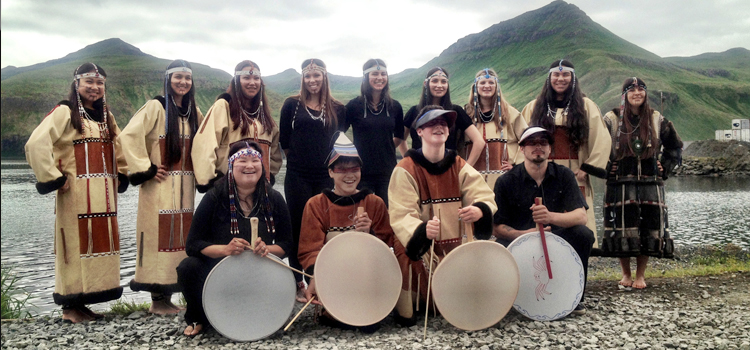
People
The people who settled along the Aleutian archipelago are often referred to as Aleut. This name was given to them by Russian fur traders, but most prefer to call themselves Unangax^, or coastal people. It is believed that the Unangax^ people migrated across the Bering land bridge from Asia between 12,000 and 15,000 years ago.
The Unangax^ people lived underneath the earth in semi-subterranean houses called ulax and developed specialized skills to survive in the harsh climate. They hunted marine mammals from skin-covered kayaks, or iqyax. The Unangax^ subsisted for centuries and thrived as a culture until Russian fur traders discovered the Aleutian Islands around 1750. At the time, the Aleut population was estimated at 12,000 to 15,000.
The fur traders from Russia occupied the islands and their people in their quest to obtain sea otters and fur seals. The population of Unangan was greatly reduced after Russian occupation due to disease, war and malnutrition. The Unangax^ also suffered tremendous loss during World War II when the U.S. government relocated most of the Aleutian Island residents to internment camps located in Southeast Alaska. Many Unangax^ died in these camps, further reducing their population. The U.S. government eventually passed a congressional act in 1988 called the Aleut Restitution Act. The purpose of this act was to pay restitution to the victims of WWII internment.
Many Unangax^ still rely on the sea for their livelihood. Most live a subsistence lifestyle which includes fishing and hunting. It is believed that today the Unangax^ population is approximately 2,000.
Language
Unangam Tunuu is its own distinct language, indicating that there has been a long period of geographical, cultural and linguistic separation of its speakers from other Alaska Native groups. While it was once spoken throughout the region, today only about 109 individuals speak it fluently.
At the time of foreign contact, Unangam Tunuu probably had multiple regional dialects—mutually intelligible, but with certain distinct features of structure and vocabulary. However, by the time the language was recorded in the early 1800s, only three of these dialects remained. The Attuan dialect was spoken by Unangan of the far western end of the archipelago, including those on Attu Island. The Atkan dialect was spoken in the central portion of the region, including today’s village of Atka, the last surviving traditional Unangan community in the area. From Umnak Island eastward to the Alaska Peninsula, the eastern Unangax dialect was spoken.
Religion
The early Russian period was a devastating time for Unangax. By 1800, little more than 50 years after first Russian contact, the Unangax population had been reduced by some 80 percent. With population loss, came far fewer occupied settlements and the consolidation and relocation of many villages and a new religion, Russian Orthodoxy. By the later eighteenth century, even before the first Russian Orthodox priests had arrived from Russia, Unangax were being baptized into the church by Russian laymen, and Russian Orthodoxy quickly became the sole religion of the region and remains the majority religion today playing a key role in village life.
The following organizations are dedicated to preserving Aleut history and culture:
Aleutian Pribilof Island Association
[/kc_column_text][/kc_column][/kc_row]


